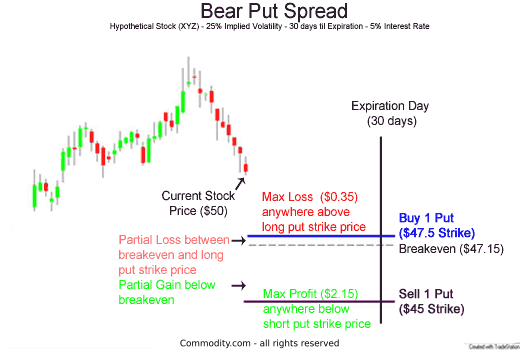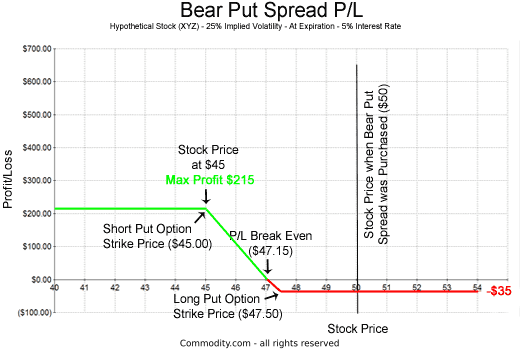This technical trading guide explains what a Bear Put Spread is and how traders use it to make better informed decisions.
Contents
We also discuss the potential risk-defined benefits of Bear Put Spreads, the formulas to calculate proft, loss, and break-even points, and a direct comparison of Bear Put Spreads alongside Put Options.
Read on to find out why a Beat Put Spread is considered a lower-risk choice.
What Is A Bear Put Spread?
A Bear Put Spread, also known as a put debit spread, is a bearish strategy involving two put option strike prices:
- Buy one at-the-money or out-of-the-money put
- Sell one put further away from the money than the put purchased
A trader would use a Bear Put Spread in the following hypothetical situation:
- A trader is very bearish on a particular stock trading at $50.
- The trader is either risk-averse, wanting to know before-hand their maximum loss, or wants greater leverage than simply owning a stock.
- The trader expects the stock to move below $47.15 but not lower than $45.00 in the next 30 days.

Buy One Put And Sell One Put
Given those expectations, the trader selects the $47.50 put option strike price to buy which is trading for $0.44.
For this example, the trader will buy only 1 option contract (Note: 1 contract is for 100 shares) so the total cost will be $44 ($0.44 x 100 shares/contract).
Also, the trader will sell the further out-of-the money put strike price at $45.00. By selling this put, the trader will receive $9 ($0.09 x 100 shares/contract).
The net effect of this transaction is that the trader has paid out $35 ($44 paid – $9 received).
Risk Defined & Profit Defined
When a Bear Put Spread is purchased, the trader instantly knows the maximum amount of money they can possibly lose and the maximum amount of money they can make.
The max loss is always the premium paid to own the option contract minus the premium received from the off-setting put option sold; in this example, $35 ($44 – $9).
What Is The Risk-Defined Benefit Of Options Trading?
Whether the stock rises to $95 or $55 a share, the put option holder will only lose the amount they paid for the option spread ($35).
This is the risk-defined benefit often discussed as a reason to trade options. Similarly, the Bear Put Spread is profit-defined as well.
The max the trader can make from this trade is $215. How this max profit is calculated is given in detail on the next page.
Bear Put Spreads Require Calculated Predictions
The important part about selecting an option strategy and option strike prices, is the trader’s exact expectations for the future.
If the trader expects the stock to move lower, but only $1 lower, then buying the $47.50/$45.00 Bear Put Spread would be foolish.
This is because at expiration, if the stock price is anywhere above $47.50, whether it be $125 or $47.51, the spread strategy will expire as worthless.
Therefore, if a trader was correct on their prediction that the stock would move lower by $1, they would still have lost.
When Might It Be Better To Buy A Put?
Moreover, if the trader is exceptionally bearish and thinks the stock will move down to $40, then the trader should just buy a put rather than purchase a Bear Put Spread.
In this example, the trader would not gain anymore profit once the stock moved below $45. This is explained on the next page.
Bear Put Spread Profit, Loss, & Breakeven
The following is the profit/loss graph at expiration for the Bear Put Spread in the example given on the previous page.

Calculating The Break-Even Point
The breakeven point for the bear put spread is given next:
Breakeven Stock Price = Purchased Put Option Strike Price – Net Premium Paid (Premium Paid – Premium Sold).
To illustrate, the trader purchased the $47.50 strike price put option for $0.44, but also sold the $45.00 strike price for $0.09, for a net premium paid of $0.35. The strike price paid was $47.50.
Therefore, $47.50 – $0.35 = $47.15. The trader will breakeven, excluding commissions/slippage, if the stock reaches $47.15 by expiration.
What Will Be The Maximum Profit?
The breakeven point for the bear put spread is given next:
Breakeven Stock Price = Purchased Put Option Strike Price – Net Premium Paid (Premium Paid – Premium Sold).
To illustrate, the trader purchased the $47.50 strike price put option for $0.44, but also sold the $45.00 strike price for $0.09, for a net premium paid of $0.35. The strike price paid was $47.50.
Therefore, $47.50 – $0.35 = $47.15. The trader will breakeven, excluding commissions/slippage, if the stock reaches $47.15 by expiration.
How To Calculate Partial Profit
Partial profit is calculated via the following, assuming the stock price is greater than the breakeven price:
Bear Put Spread Partial Profit = Breakeven price – Stock price
For instance, the stock closed at $46.00 at expiration.
Hence, the breakeven stock price ($47.15) minus the stock price at expiration ($46.00) would mean the trader profited $115 [($47.15 – $46.00) x 100 shares/contract]
How To Calculate Partial Loss
A partial loss occurs between the breakeven stock price and the upper purchased put strike price. The calculation is given next:
Bear Put Spread Partial Loss = Stock price – Breakeven price
For example, a closing stock price at expiration of $47.40 is between the upper put strike price of $47.50 and the breakeven of $47.15 and is therefore going to be a partial loss. When calculated, the loss is $25 [($47.40 – $47.15) x 100 shares/contract].
How To Calculate Complete Loss
A complete loss occurs anywhere above the upper purchased put strike price ($47.50) which amounts to the entire premium paid of $35.
Bear Put Spread vs. Put Option
The Bear Put Spread is liked by many traders more than simply buying a put option for two main reasons:
- Reduces the capital spent/higher breakeven price.
- Is a strategy than incorporates reality.
Bear Put Spreads Are Cheaper WIth A Lower Break-Even Price
Because a bear put spread involves the selling of an option, the money required for the strategy is less than buying a put option outright.
Moreover, the breakeven price is raised when implementing a bear put spread.
To illustrate the cash outlay and breakeven prices for a bear put spread and just a put option are given next:
- Bear Put Spread: cost $35; breakeven price $47.15
- Put Option: cost $44; breakeven price $47.06
On a percentage basis, the bear put spread is over 20% cheaper than the cost of just purchasing a put.
How Realistic Are The Trader’s Expectations?
The second advantage/disadvantage of a bear put spread is that this strategy considers the reality and probabilities of a potential move.
Theoretically, buying a put strategy has great profit potential.
However, successful options traders generally focus on probabilities and take reality into consideration. A stock move from $50 to $45 is a 10% move. This has to occur in the time before expiration, in the example 30 days.
In order for a rational options trader to buy just a put, the option trader has to expect a stock move lower that is greater than 10% within 30 days.
Is The Bear Put Spread A Worthwhile Alternative To Put Options?
In conclusion, the bear put spread is a great alternative to simply buying a put outright, since it:
- Reduces the distance of the breakeven price
- Decreases the capital required to be bearish on a stock
- Takes into realistic expectations into consideration
Where Can I Start Trading?
If you are interested in trading using technical analysis, have a look at our reviews of these regulated brokers available in to learn which charting tools they offer:
CFDs are complex instruments and come with a high risk of losing money rapidly due to leverage. Between 74%-89% of retail investor accounts lose money when trading CFDs. You should consider whether you can afford to take the high risk of losing your money.
Further Reading
Learn more about technical analysis charting concepts and strategies including Typical Price Moving Average, and Average Directional Movement, and Triangular Moving Average.
Also, see our guide to understanding the basics of reading candlestick charts and option trading strategies.


